2013 Peugeot 508 ABS
[x] Cancel search: ABSPage 31 of 340
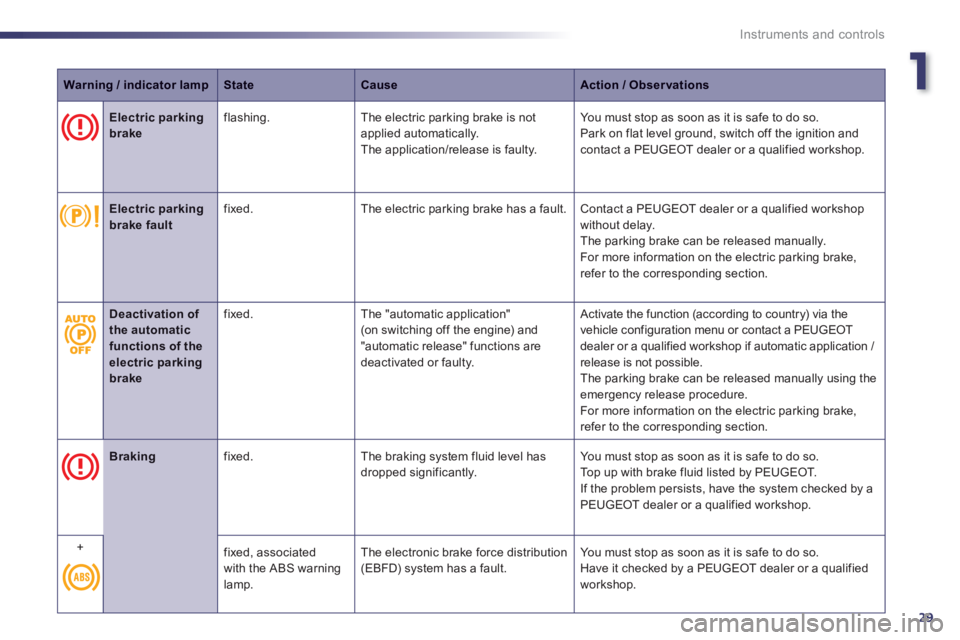
1
29
Instruments and controls
Warning / indicator lampStateCauseAction / Observations
Electric parking brake
flashing.The electric parking brake is not
applied automatically.
The application/release is faulty. You must stop as soon as it is safe to do so.
Park on flat level ground, switch off the ignition and contact a PEUGEOT dealer or a qualified workshop.
Electric parking brake fault
fixed. The electric parking brake has a fault. Contact a PEUGEOT dealer or a qualified workshop
without delay.
The parking brake can be released manually.
For more information on the electric parking brake,
refer to the corresponding section.
Braking
fixed. The braking system fluid level has
dropped significantly. You must stop as soon as it is safe to do so.
Top up with brake fluid listed by PEUGEOT.
If the problem persists, have the system checked by a
PEUGEOT dealer or a qualified workshop.
+
fixed, associated
with the ABS warning
lamp. Th
e electronic brake force distribution(EBFD) system has a fault. You must stop as soon as it is safe to do so.
Have it checked by a PEUGEOT dealer or a qualified
wor
kshop.
Deactivation of the automatic functions of the electric parkingbrake
fixed. The "automatic application" (on switching off the engine) and
"automatic release" functions aredeactivated or faulty.
Activate the function (according to country) via the
vehicle configuration menu or contact a PEUGEOT
dealer or a qualified workshop if automatic application /
release is not possible.
The parkin
g brake can be released manually using the emergency release procedure.
For more information on the electric parking brake,
refer to the corresponding section.
Page 32 of 340
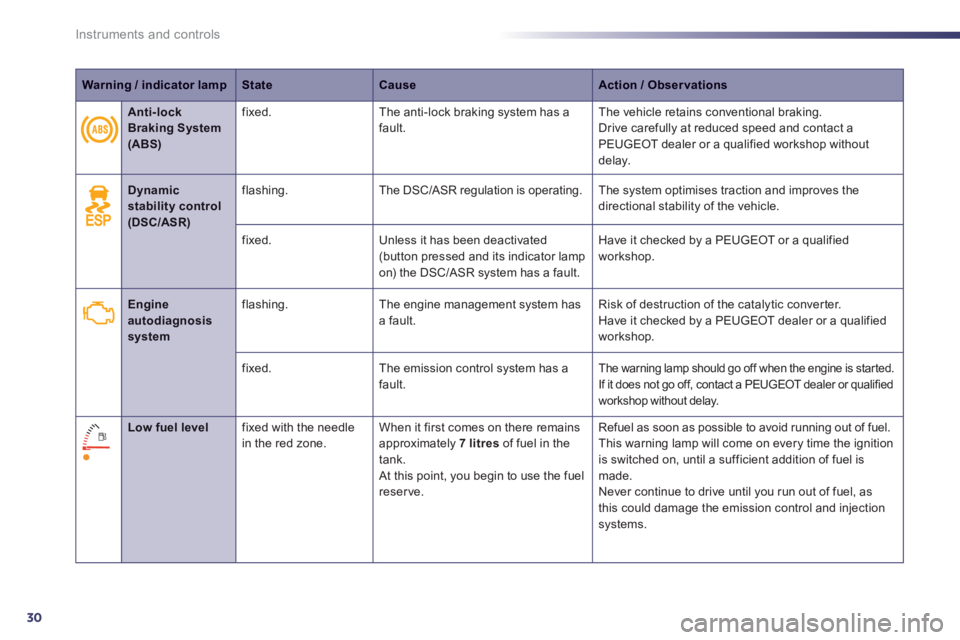
30
Instruments and controls
Warning / indicator lampStateCauseAction / Observations
Dynamic stability control(DSC/ASR)
flashing. The DSC/ASR regulation is operating. The system optimises traction and improves the
directional stability of the vehicle.
fix
ed.Unless it has been deactivated(button pressed and its indicator lamp
on) the DSC/ASR system has a fault.Have it checked b
y a PEUGEOT or a qualified
workshop.
Engine autodiagnosis system
flashing.The engine management system hasa fault. Risk of destruction of the catalytic conver ter.
Have it checked by a PEUGEOT dealer or a qualified
workshop.
fix
ed. The emission control system has afault. The warning lamp should go off when the engine is started.
If it does not go off, contact a PEUGEOT dealer or qualified
workshop without delay.
Low fuel levelfixed with the needle
in th
e red zone. Wh
en it first comes on there remains
approximately 7 litresof fuel in the
tank.
At this point, you begin to use the fuel reserve.Re
fuel as soon as possible to avoid running out of fuel.
This warnin
g lamp will come on every time the ignition
is switched on, until a sufficient addition of fuel is
made.
Never continue to drive until you run out of fuel, as
this could damage the emission control and injectionsystems.
Anti-lockBraking System(ABS)
fixed.The anti-lock braking system has afault. The vehicle retains conventional braking.
Drive carefully at reduced speed and contact a
PEUGEOT dealer or a qualified workshop without
dela
y.
Page 40 of 340
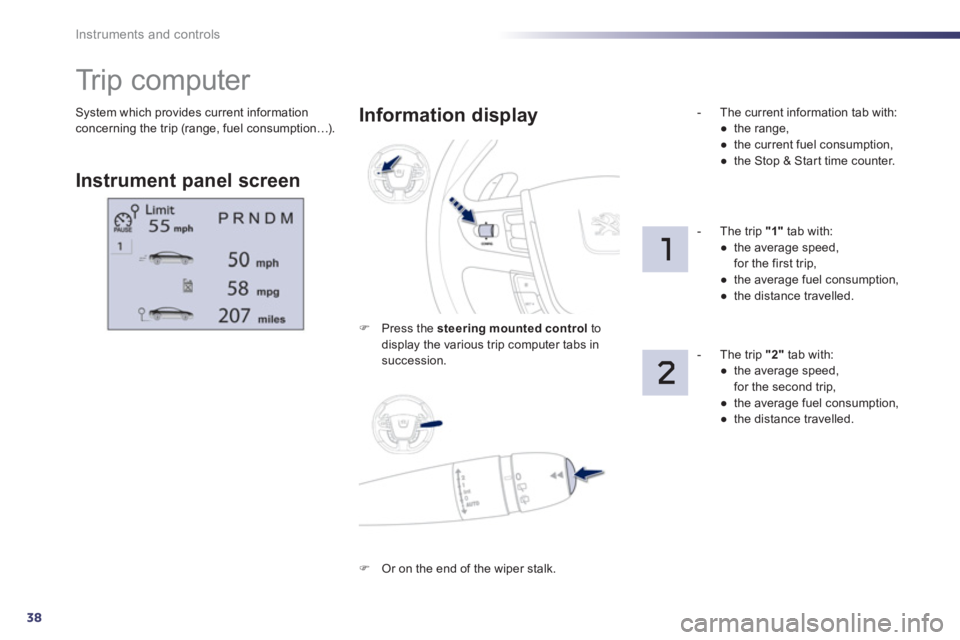
38
Instruments and controls
System which provides current information concerning the trip (range, fuel consumption…).
Tr i p c o m p u t e r
Instrument panel screen
Information displa
y
F
Press the steering mounted control
todisplay the various trip computer tabs in succession.
- Th
e current information tab with:
●
the range,
●
the current fuel consumption,
●
the
Stop & Start time counter.
-
The trip "1"tab with:
●
the average speed,
for the first trip,
●
the average fuel consumption,
●
the distance travelled.
-
The trip "2"
tab with:
●
the average speed,
for the second trip,
●
the average fuel consumption,
●
the distance travelled.
F
Or on the end of the wiper stalk.
Page 56 of 340
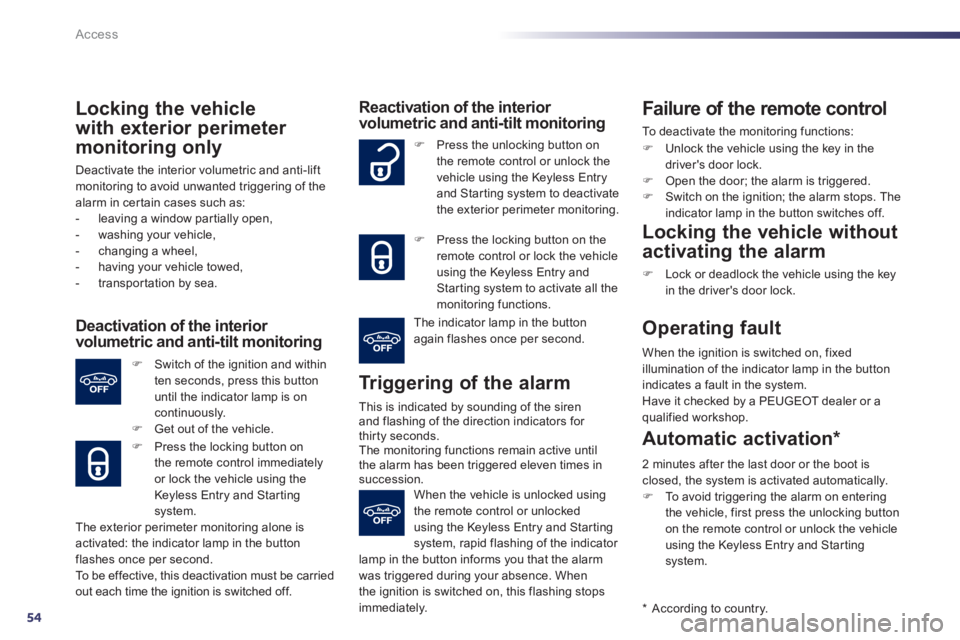
54
Access
Locking the vehicle
w
ith exterior perimeter
monitoring only
Deactivate the interior volumetric and anti-liftmonitoring to avoid unwanted triggering of thealarm in certain cases such as:
- leaving a window par tially open,
- washing your vehicle,
- changing a wheel,
- having your vehicle towed,
- transportation by sea.
Deactivation of the interior volumetric and anti-tilt monitoring
F
Switch of the ignition and within
ten seconds, press this button
until the indicator lamp is on
continuously.F Get out of the vehicle.
F
Press the locking button on
the remote control immediatelyor lock the vehicle using the Keyless Entry and Starting system.
The exterior perimeter monitoring alone is activated: the indicator lamp in the button
flashes once per second.
To b e e
ffective, this deactivation must be carried
out each time the ignition is switched off.
Reactivation of the interior volumetric and anti-tilt monitoring
Tr iggering of the alarm
This is indicated by sounding of the siren
and flashing of the direction indicators for
thirty seconds.
The monitoring functions remain active until
the alarm has been triggered eleven times in succession.
FPress the unlocking button on
the remote control or unlock thevehicle using the Keyless Entry and Starting system to deactivate
the exterior perimeter monitoring.
F Press the locking button on theremote control or lock the vehicle
using the Keyless Entry and Starting system to activate all the monitoring functions.
The indicator lamp in the button
again flashes once per second.
When the vehicle is unlocked usingthe remote control or unlockedusing the Keyless Entry and Starting
system, rapid flashing of the indicator lamp in the button informs you that the alarm
was triggered during your absence. When
the ignition is switched on, this flashing stopsimmediately.
Failure of the remote control
To deactivate the monitoring functions:
F
Unlock the vehicle using the key in thedriver's door lock. F
Open the door; the alarm is triggered.F
Switch on the ignition; the alarm stops. The
indicator lamp in the button switches off.
Locking the vehicle without
activating the alarm
F
Lock or deadlock the vehicle using the keyin the driver's door lock.
Operating fault
When the ignition is switched on, fixed
illumination of the indicator lamp in the button
indicates a fault in the system.
Have it checked by a PEUGEOT dealer or a qualified workshop.
*
According to country.
Automatic activation *
2 minutes after the last door or the boot isclosed, the system is activated automatically. F
To avoid triggering the alarm on entering
the vehicle, first press the unlocking buttonon the remote control or unlock the vehicleusing the Keyless Entry and Star ting system.
Page 161 of 340
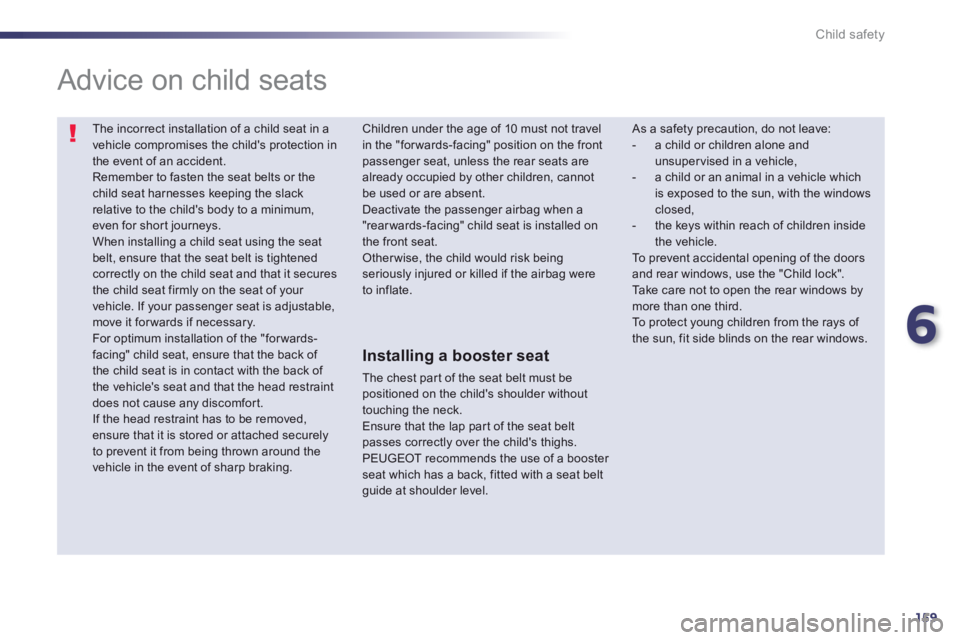
6
159
Child safety
The incorrect installation of a child seat in avehicle compromises the child's protection in the event of an accident.
Remember to fasten the seat belts or the child seat harnesses keeping the slack relative to the child's body to a minimum,
even for shor t journeys.
When installing a child seat using the seat belt, ensure that the seat belt is tightenedcorrectly on the child seat and that it secures the child seat firmly on the seat of your vehicle. If your passenger seat is adjustable, move it for wards if necessary.
For optimum installation of the "forwards-facing" child seat, ensure that the back of the child seat is in contact with the back of the vehicle's seat and that the head restraint does not cause any discomfort.
If the head restraint has to be removed, ensure that it is stored or attached securely to prevent it from being thrown around the vehicle in the event of sharp braking.
Advice on child seats
As a safety precaution, do not leave: - a child or children alone and unsupervised in a vehicle, - a child or an animal in a vehicle whichis exposed to the sun, with the windows closed,
- the keys within reach of children inside the vehicle. To prevent accidental opening of the doors and rear windows, use the "Child lock". Take care not to open the rear windows bymore than one third.To protect young children from the rays of the sun, fit side blinds on the rear windows.
Children under the age of 10 must not travel in the "forwards-facing" position on the front passenger seat, unless the rear seats are already occupied by other children, cannot be used or are absent.
Deactivate the passenger airbag when a
"rearwards-facing" child seat is installed on the front seat. Other wise, the child would risk beingseriously injured or killed if the airbag were to inflate.
Installing a booster seat
The chest par t of the seat belt must be positioned on the child's shoulder without touching the neck.
Ensure that the lap part of the seat belt passes correctly over the child's thighs.
PEUGEOT recommends the use of a booster seat which has a back, fitted with a seat belt guide at shoulder level.
Page 167 of 340
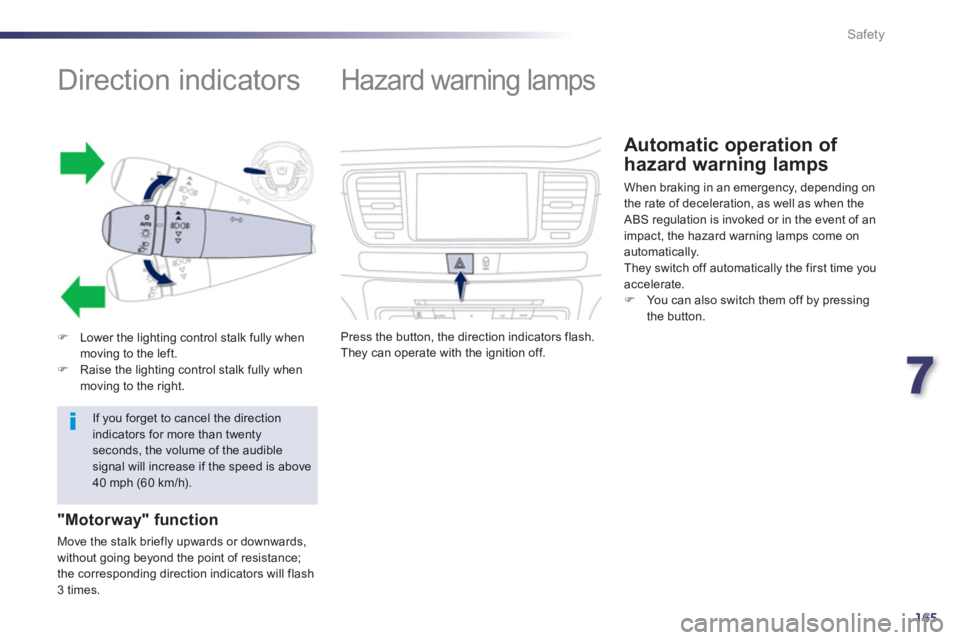
7
165
Safety
Direction indicators
F
Lower the lighting control stalk fully when moving to the left. F
Raise the lighting control stalk fully when moving to the right.
"Motorway" function
Move the stalk briefly upwards or downwards,
without going beyond the point of resistance;
the corresponding direction indicators will flash 3 times.
If you forget to cancel the direction indicators for more than twenty seconds, the volume of the audible signal will increase if the speed is above40 mph (60 km/h).
Hazard warning lamps
Press the button, the direction indicators flash.
They can operate with the ignition off.
Automatic operation of
hazard warnin
g lamps
When braking in an emergency, depending on
the rate of deceleration, as well as when the ABS regulation is invoked or in the event of animpact, the hazard warning lamps come on
automatically.
They switch off automatically the first time you accelerate.F
You can also switch them off by pressingthe button.
Page 170 of 340
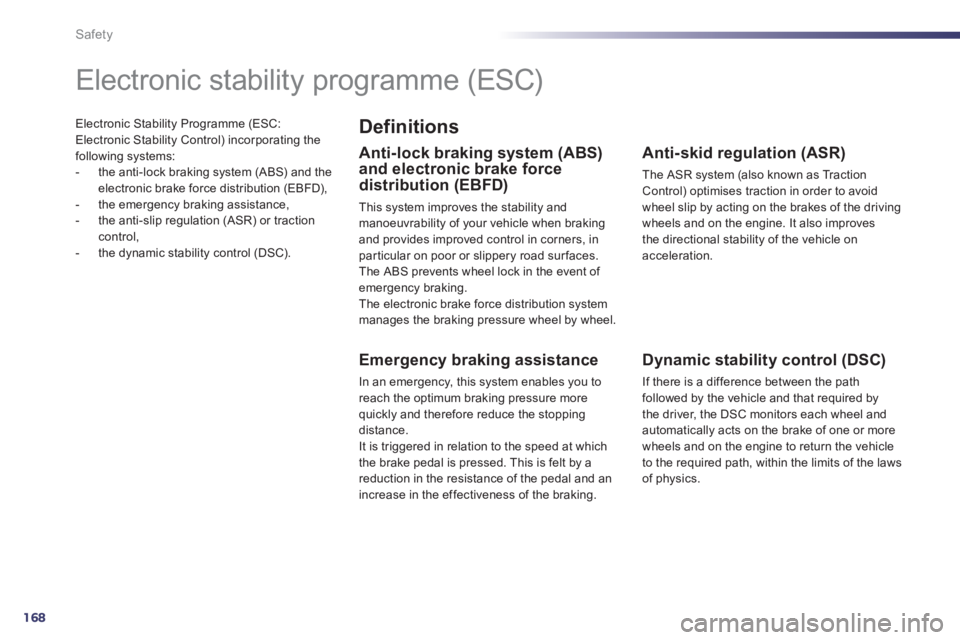
168
Safety
Electronic Stability Programme (ESC: Electronic Stability Control) incorporating the
following systems:
- the anti-lock braking system (ABS) and the
electronic brake force distribution (EBFD),
- the emergency braking assistance,
- the anti-slip regulation (ASR) or traction
control,
- the dynamic stability control (DSC).
Electronic stability programme (ESC)
Definitions
Anti-lock braking system (ABS)
and electronic brake force
distribution
(EBFD)
This system improves the stability and
manoeuvrability of your vehicle when braking
and provides improved control in corners, in
par ticular on poor or slippery road surfaces.
The ABS prevents wheel lock in the event of emergency braking.
The electronic brake force distribution system
manages the braking pressure wheel by wheel.
Emergency braking assistance
In an emergency, this system enables you to reach the optimum braking pressure more quickly and therefore reduce the stoppingdistance.
It is triggered in relation to the speed at which
the brake pedal is pressed. This is
felt by areduction in the resistance of the pedal and an
increase in the effectiveness of the braking.
Anti-skid regulation (ASR)
The ASR system (also known as Traction Control) optimises traction in order to avoid
wheel slip by acting on the brakes of the drivingwheels and on the engine. It also improves
the directional stability of the vehicle onacceleration.
Dynamic stability control (DSC)
If there is a difference between the pathfollowed by the vehicle and that required bythe driver, the DSC monitors each wheel and
automatically acts on the brake of one or more
wheels and on the engine to return the vehicle
to the re
quired path, within the limits of the laws
of physics.
Page 171 of 340
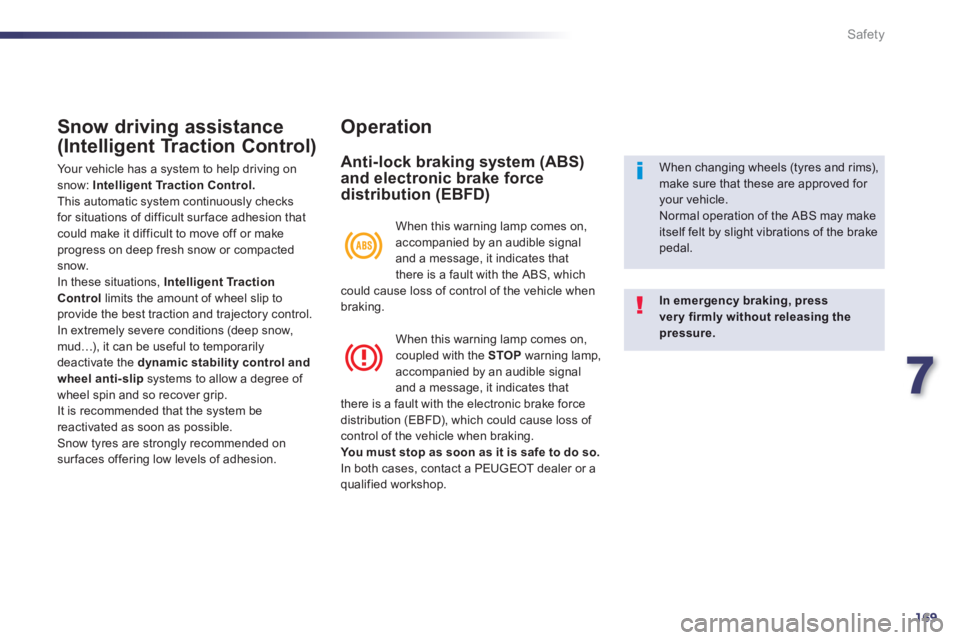
7
169
Safety
Snow driving assistance
(Intelligent Traction Control)
Your vehicle has a system to help driving on snow: Intelligent Traction Control. This automatic system continuously checks for situations of difficult surface adhesion thatcould make it difficult to move off or makeprogress on deep fresh snow or compacted snow.
In these situations, Intelligent Traction
Controllimits the amount of wheel slip to provide the best traction and trajectory control.
In extremely severe conditions (deep snow,mud…), it can be useful to temporarilydeactivate the dynamic stability control andwheel anti-slip
systems to allow a degree of
wheel spin and so recover grip.
It is recommended that the system be
reactivated as soon as possible.
Snow t
yres are strongly recommended on sur faces offering low levels of adhesion.
Operation
Anti-lock braking system (ABS)and electronic brake force
distribution (EBFD)
In emergency braking, press very firmly without releasing the pressure.
When changing wheels (tyres and rims),make sure that these are approved for your vehicle.
Normal operation of the ABS may makeitself felt by slight vibrations of the brake pedal. When this warnin
g lamp comes on,
accompanied by an audible signal
and a message, it indicates that
there is a fault with the ABS, which could cause loss of control of the vehicle whenbraking.
When this warnin
g lamp comes on,coupled with the STOPwarning lamp,
accompanied by an audible signaland a message, it indicates that
there is a fault with the electronic brake forcedistribution (EBFD), which could cause loss of control of the vehicle when braking.
You must stop as soon as it is safe to do so.In both cases, contact a PEUGEOT dealer or a qualified workshop.